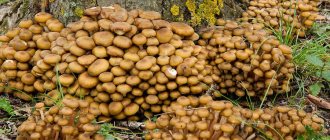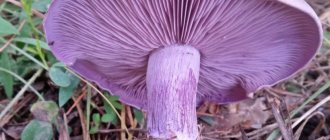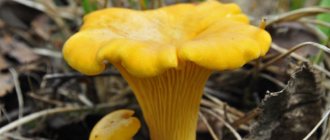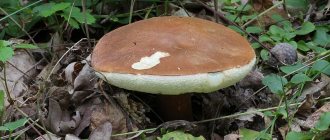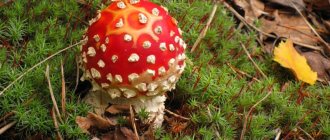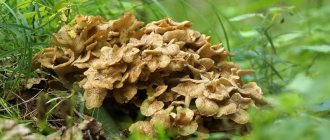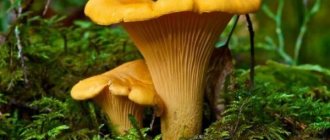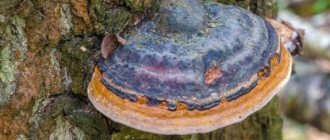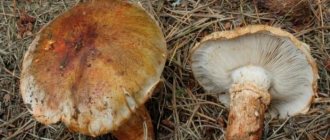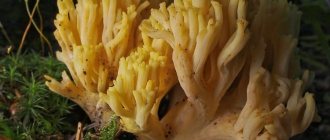Red, green and brown, they can have a quite pleasant taste and at the same time be highly poisonous - of course, we are talking about russula.
This mushroom is divided into different types, on which its color and edible qualities depend, and during culinary processing it requires minimal effort, which is how it got its name.
It belongs to the kingdom of fungi, the class Agaricomycetes, the genus Lamelidae and the Russula family named after it.
Russula mushroom – photo and description
Despite their diversity and individual properties of the species, all russula have a similar structure and similar external characteristics, differing only in the color of the cap, which with age turns from round to flatter with raised brims.
Its diameter can reach up to 15 cm, and the color varies from more natural tones (green and brown) in edible mushrooms to bright and eye-catching (red) in poisonous ones.
Here and further in the article you can see a photo of the Russula mushroom and see for yourself how different individual representatives of this family are from their counterparts.
To make it even more deceptive, you can see small yellow spots on the caps of some russulas, and they feel completely different to the touch depending on the weather - both dry and sticky. The skin on them, as a rule, is matte and shiny, easily separated from the pulp, which is a definite advantage during culinary processing.
However, in addition to different caps, russulas also differ in the color of their legs and plates. Their color is light, ranging from white to yellow tones, like the color of the spore powder. Sometimes pink shades are found, but only in poisonous individuals.
In terms of its structure, the pulp of russula is white, dense and slightly elastic, but with age it turns into fragile and brittle, crumbly.
Contraindications for use
Many species have some bitterness and, when raw or undercooked, can cause digestive disorders, and russula stinging, which is also called nauseating, provokes vomiting and severe irritation of the mucous membranes.
Mushrooms are not recommended for food for people with gastrointestinal diseases. Marinated mushroom preparations and fried foods in large quantities put a strain on the liver, especially with gallbladder pathologies. Therefore, such foods are eaten in moderation and with caution.
You should not include russula in the diet of children under six years of age - this is a heavy food for them, requiring the active work of enzymes, the production of which is still insufficient in the child’s body.
It would be useful to remind you of the enormous danger that threatens the unlucky mushroom picker, who can confuse russula with poisonous mushrooms, especially with toadstool.
Variety of species
By their nature, russula are so diverse, but at the same time similar to each other, that sometimes even experts cannot with complete confidence attribute any mushroom to one or another species.
There are 750 species of russula in total, which greatly complicates the matter, but there are still criteria by which a person can navigate the family of these mushrooms. Of course, these are external characteristics.The color of the cap and legs, plates and spores is quite a convenient thing, instantly catching the eye, but even with this taken into account, only 20-30 species are easily distinguished, while the rest have to be puzzled over and resort to chemical analysis.
On the territory of Russia you can find about 60 representatives of the Russula family.
Most people who are interested in collecting mushrooms or who seriously study them divide russula into three categories:
- edible;
- inedible;
- poisonous.
To distinguish the representatives of the last two points from the first, you just need to look closely and smell.
If the cap is too bright, the color of the flesh gradually changes during cooking, and the mushroom itself emits an unpleasant odor, it is better to avoid the suspicious object.
When to collect?
Russula grows on the edges, clearings, and in all forests. The first young mushrooms appear in June, and the most productive time is in August. The most delicious russulas have yellow and green caps. Do not collect overgrown gifts of nature, they accumulate harmful foreign substances from the environment. Fresh, young mushrooms that have not been bitten by insects are suitable for food. Throw away wormy specimens immediately.
In order to return to a well-known place next time and collect a rich harvest of mushrooms, you should spare the mycelium: russula, like any gifts of nature, cannot be pulled out of the ground, they must be carefully cut off at the base with a knife.
Safety regulations:
- Don't pick a mushroom without identifying it. Collect only those specimens that you are sure of, otherwise you can cut off an inedible poisonous product that can cause intoxication of the body and even lead to death.
- All russula on the inside have white plates, white legs, without scales, films, or rings. Cut mushrooms practically do not change color. They remain white (rarely - barely turn yellow).
- If it rains heavily in the summer, avoid picking mushrooms, as they have become saturated with water, lost their taste, and released toxic substances.
- After harvesting, the mushrooms are re-sorted to identify “random” unsuitable specimens, then placed in a cool salty solution for an hour or three to eliminate insects and a bitter taste.
- Before eating russula, they are subjected to reliable heat treatment! Do not consume the product raw under any circumstances!
Mushrooms are picked in the morning before the sun heats them up. This way they will last longer. The cut specimens are immediately cleaned of debris, adhering needles, grass, soil and leaves, and placed in a basket with the cap down.
Mushroom picker equipment:
- stick for searching for mushrooms;
- electronic GPS navigator;
- mushroom basket;
- disinfectant and patch;
- telephone (to call emergency services);
- basket and knife for mushrooms;
- water and sandwiches.
Remember, poisonous mushrooms are often disguised as edible ones, so before you go into the forest, refresh the information on how to distinguish a good specimen from a toadstool. Don't put your health at mortal risk.
Mushroom is a treacherous product, follow safety rules!
Medicinal properties
In addition to a pleasant taste, some russula have medicinal properties. For example, extracts have a beneficial effect on blood lipids, and the properties of the mycelium make it possible to produce alcohol preparations, which are very helpful for certain cancer diseases.
Extracts prepared from young russula have an antiparasitic effect, cleansing the human body, and in folk medicine these mushrooms are used as a diuretic.
Chemical composition
Russula is a dietary product rich in beneficial minerals, vitamins, and elements.
Mushrooms take a long time to digest in the body, creating a feeling of fullness, therefore they are recommended for consumption by people (in boiled form) who have embarked on the path of fighting excess weight. Table No. 1 “Nutritional value of russula”
| Components | Contents per 100 grams of product |
| Calorie content | 19 calories |
| Water | 90 grams |
| Alimentary fiber | 5.5 grams |
| Squirrels | 1.7 grams |
| Carbohydrates | 1.5 grams |
| Mono- and disaccharides | 1.5 grams |
| Ash | 0.6 grams |
| Omega-6 | 0.18 grams |
| Omega-3 | 0.175 grams |
| Saturated fatty acids (stearic, myristic, palmitic) | 0.091 grams |
| Omega-9 | 0.058 grams |
Table No. 2 “Chemical composition of russula”
| Name | Nutrient content per 100 grams of product, milligrams |
| Vitamins | |
| Ascorbic acid (C) | 12,0 |
| Niacin (B3) | 6,4 |
| Riboflavin (B2) | 0,3 |
| Tocopherol (E) | 0,1 |
| Thiamine (B1) | 0,01 |
| Macronutrients | |
| Potassium | 269 |
| Phosphorus | 40 |
| Magnesium | 11 |
| Calcium | 4 |
| Sodium | 4 |
| Microelements | |
| Iron | 0,6 |
Russulas contain lecithin, an essential substance for the human body. This is a fat-like organic compound, a building material for cell membranes. Lecithin consists of 17% of nerve tissue, 30% of the brain and 50% of the human liver. It improves memory, strengthens brain activity, preserves the conductivity of nerve fibers, protects liver cells, normalizes the composition of bile, and strengthens the heart muscle. Without lecithin, proper absorption of fat-soluble nutrients (A, E, ,) is impossible.
Collection and cooking
To collect mushrooms you will need a well-sharpened knife, as well as a basket or enamel bucket. Under no circumstances should galvanized buckets or plastic bags be used.
When you find a mushroom, carefully cut it off, but do not uproot it - in order for the russula to continue to multiply, it is necessary to leave the mycelium in the ground intact.
Before any culinary processing, russula must be soaked. They can be boiled, fried, stewed and pickled, but they are completely unsuitable for drying.
These gifts of the forest are very diverse and tasty if you approach them correctly. Bon appetit.
- Talker - description of the species, distribution of the species, benefits and harm + 79 photos
- Gall mushroom - description of appearance, seasonality, taste + 69 photos
- Rizhik - where and at what time it grows, benefits, recipes + 90 photos
Edibility assessment
This russula is an edible species. It can be consumed even without heat treatment, but in this form it has an unpleasant aftertaste. After heat treatment it disappears. In the existing classification, this variety belongs to the fourth category. There are many recipes with this type of mushroom.
Before cooking, they must be cleaned and rinsed with special care.
Given the special fragility of the structure of russula, they are most often fried or stewed. Pickling is allowed. Young fruits, which have a denser structure, are better suited for this. After drying, the fruiting bodies become even more fragile. The dried fruits are often used to make mushroom soups.
